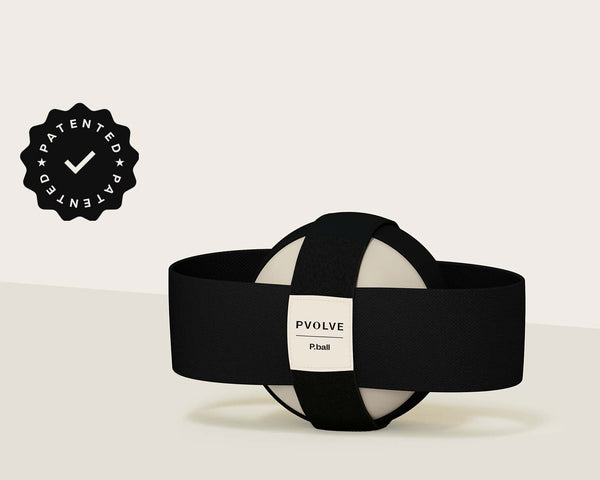Your pelvic floor—just like your arms, abs and glutes—can be strengthened and weakened with exercise and everyday activity. But just how much attention should you give to making this essential muscle group as strong as can be?
Two of our experts, Sex and Relationship Therapist Carli Blau and Pvolve Chief Physical Therapist Dr. Amy Hoover, are here to give you a well-rounded understanding of all that goes on down below. It's the perfect pelvic floor refresher before diving into our Pelvic Floor Strengthening Program.
How does someone know if they have a weak pelvic floor?
Carli: We’ve already discussed getting a pelvic floor diagnosis to know what kind of pelvic floor you have, but so many women explain afterwards that they wish someone told them they would have an intravaginal exam. Regardless, during this evaluation is when someone can learn if their pelvic floor is weakened. A hypotonic pelvic floor dysfunction could come in the form of urinary incontinence. So, think of it as the opposite of a hypertonic (or too tight) pelvic floor. You could leak, a trickle of pee and then an overfilled bladder. Women aren’t alone—men can experience both of these, as well! They may also benefit from the Pvolve Method, too.
How will a first-time pelvic floor exam go?
Dr. Amy: Pelvic floor therapy is no different than other therapy, except one thing: an internal vaginal or rectal exam if warranted, and of course consented to. These therapists are specially trained to do an internal exam of your pelvic floor. So what does that actually mean?
- It'll start with a general assessment to talk more about your issues, plus more detailed things like assessing your breathing pattern, checking on your abdominal wall and trigger points.
- The therapist will first do a visual exam of the external genital area, urethra, clitoris and anus, checking for skin integrity or signs of irritation. They may use a light to have better visibility. Then, they'll usually check the outer layer or superficial layer of pelvic floor muscles, in the area of the vulva, labia and perineum.
- They’ll ask you to contract your pelvic floor and watch to see if the perineum draws up and in towards your head. Then they will ask you to bear down or push like you’re going to the bathroom, which is an active lengthening of the pelvic floor. If needed, they'll use lubricant or will insert one or two fingers to check the deeper pelvic floor muscles for resting muscle tone, tight bands and of course strength. (One other thing to note is that we do not use a speculum like gynecologists, because we are examining muscle and not the uterus or cervix.)
After going through these steps and trials, your doctor will likely be able to suggest a treatment plan with you.
How can exercise help work the pelvic floor to strengthened, but not too tight?
Carli: If the pelvic floor is too tight, you can exercise muscles around the pelvic floor to release the pelvic floor and not have to strengthen it any more to become even tighter. Or, you can use something like Pvolve to hone in on this particular area.
Dr. Amy: In general, women with hypertonic pelvic floor or PFD (pelvic floor dysfunction) should not be strengthening the pelvic floor. It’s like if you have a hamstring strain or pulled muscle you would not want to do a bunch of hamstring curls or strengthening as this could make it worse. However, movement and hip openers can help reduce tone in the pelvic floor and can reduce symptoms. Pvolve's hip and pelvic recovery workouts would also be beneficial for this group.
How long can I expect to see and feel my pelvic floor getting stronger?
Carli: It depends on the symptoms you experience as a result of your pelvic floor. From a sexual perspective, if you’re experiencing a stronger orgasm, or feeling like there’s less of an urge to pee before or after sex, if you’re able to feel more during sex, then you can maybe feel those changes. The most common one that I see is when a woman has increased core and pelvic floor strength, and has a stronger orgasm as a result of it.
Dr. Amy: It can take up to 6-8 weeks of consistent pelvic floor exercise to build muscle, but you may feel changes within a week or two of starting pelvic floor strengthening. The most important goal early on is to be able to understand and feel what you are doing so that you can do it correctly. Building a strong mind-body connection with your pelvic floor can help you engage these muscles correctly during larger body movements, but that takes practice. Starting by practicing isolated pelvic floor contractions while lying or sitting still helps build this connection and awareness. This can help you in situations where you might need some extra help from your pelvic floor, like coughing, sneezing or lifting. If you do these things mindfully and functionally, your body may eventually learn to do it automatically.
You might notice your pelvic floor getting stronger and more flexible with improved incontinence, less heavy feeling in the perineum or vagina, easier bowel movements and better sensory awareness during sex. Pelvic floor strength can gradually increase over a long period of time, but smaller wins can come with immediate changes to your movements.
CARLI BLAU
LMSW, M.Ed, M.A., Ph.D. Candidate in Clinical Sex Therapy

Carli Blau is a Licensed Sex and Relationship Therapist who specializes in women’s health including infertility, endometriosis, and PCOS. She is certified in Maternal Mental Health, received her Master’s of Social Work from Columbia University, a Master of Education in Human Sexuality from Widener University, and is currently working on her Ph.D. in Clinical Sex Therapy studying infertility and sexual esteem in women trying to conceive.
DR. AMY HOOVER
DPT, Chief Physical Therapist

Dr. Amy Hoover is Pvolve’s Doctor of Physical Therapy and the owner and operator of APHysio LLC, wellness practice that specializes in manual therapy, pre and post-natal care, pelvic floor disorders and more. Here at Pvolve, she’s able to share her expertise directly with our community as it applies to the method and its impact on the body.
Not a member yet? Start your free trial for access to our library of on-demand classes and start working out with us today.






































